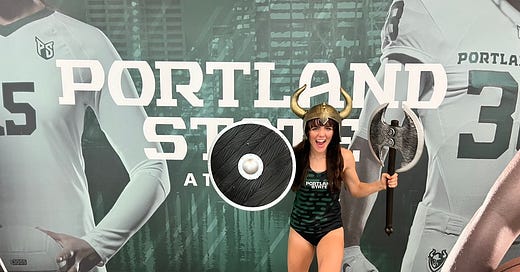The New NCAA: Where Track & Field Is Headed Next
Here are four major shifts that I could see shaping the future of NCAA competition and what they mean for high school athletes, collegiate programs, and the sport at large.
This week I’m off at Peak High Altitude Camp. It’s my favorite 2 weeks of the year. Camp is transformational for the campers, the counselors, and the coaches. We spend about 9 months making all the details come together and we stand to deliver an A+ experience for our campers. If you want to follow along - follow me @coach_simmons_runs on instagram or @peakperformancerunning to keep up. If you’re reading this afterwards, check out the details for this years camp! Let’s dig into something that’s been on my mind the last couple weeks - these are predictions - not guarantees. I want to hear you sound off in the comments!
The future of the NCAA isn’t on the horizon it’s already unfolding. From NIL to the transfer portal to high-stakes recruiting battles, track and field at the collegiate level is evolving rapidly. In this new environment, athletes are navigating more complexity and greater opportunity than ever before.
In the last 7 years, PEAK has helped more than 75 athletes find a home in the NCAA. The game is changing but it’s not all bad news - here are four major shifts that I could see shaping the future of NCAA competition and what they mean for high school athletes, collegiate programs, and the sport at large.
1. Fewer Roster Spots, Greater Specialization
While the number of elite high school athletes continues to rise, NCAA programs are becoming more selective. Many Division I teams are trimming rosters to manage scholarship budgets, Title IX constraints, and performance-based funding. This pressure is accelerating a trend toward program specialization.
Rather than broad, all-encompassing track and field teams, we’re seeing a shift toward programs that identify with a particular event group: distance-only, sprint-focused, or field-dominant teams. These specialized programs are likely to prioritize performance in one or two seasons cross country or track but not necessarily both. The most prominent was the departure of field events from the roster of Washington State announced in June 2025.
It’s likely we’ll begin to see schools drop or restructure entire event groups, making room for a narrower, higher-performing core. In the long term, this may give rise to track-only or XC-only programs, reshaping the traditional collegiate calendar and athlete expectations. I am seeing more and more of my mid-distance athletes recruited specifically for track on 1-year terms. Distance runners are usually a big win for a program as they can run XC & Distance.
2. The Transfer Portal and the Rise of the "One-Year Deal" Era
We’re entering a time when a four-year athlete at one school will become the exception, not the rule.
“In today’s landscape, growth requires clarity—not loyalty. Choose opportunity with your values in hand, not your fears. Education comes first. Running is the bonus, not the backbone.”
The transfer portal has created a dynamic marketplace for athletes. Paired with the rise of NIL (Name, Image, and Likeness), collegiate athletics are beginning to resemble semi-professional free agency. Top performers now navigate not only scholarship offers, but financial incentives from brands, collectives, and even boosters. This creates a new reality where athlete movement is strategic and expected.
Here’s how this shift is playing out in real terms:
Annual scholarship renewals are the new norm. Most athletes will now compete on one-year contracts, with performance, health, and marketability all influencing future renewals.
Coaches recruit both high school and transfer talent simultaneously. Roster management includes actively scouting the portal for plug-and-play athletes who can impact team scoring.
NIL offers can out-value pro contracts. Some athletes will choose to stay in school for all four years, not because they aren’t ready to go pro, but because remaining in the NCAA is financially more advantageous. It sure helps to have a degree when you’re done with the pro running scene!
Team culture and continuity will shift. With rosters changing yearly, building long-term team identity will become more challenging, requiring stronger leadership and adaptability. Each season will bring a new group of athletes in - it will be a badge of honor to be a “4-year” at a single institution.
This environment requires a new level of mental readiness. Athletes and families should be prepared to make data-informed, values-based decisions about movement and opportunity not out of disloyalty, but out of a desire to grow and align with the best fit. The reality is this: go to school for an education, running is secondary. You are a student first and foremost - keep the main thing, the main thing.
3. D1 Becomes Semi-Pro, D2 and D3 Become Developmental Powerhouses
As Division I moves closer to a semi-professional model with high-profile coaching hires, elevated facilities, and multimillion-dollar NIL deals Divisions II and III are solidifying their role as key development pipelines. D2 and D3 are no longer fallback plans—they're launchpads
What used to be fallback options are now seen as viable launchpads. Look no further than programs like Colorado School of Mines, Grand Valley State, or Johns Hopkins. These teams are recruiting elite talent, developing them within their training systems, and often feeding athletes back into the D1 system through the portal. In some cases the D1 talent is flowing back into D2, D3 schools that give these “D1 drop-outs” a chance to race and contribute.
This development model mirrors what we see in international sport: younger athletes grow in lower tiers, then “graduate” into elite spaces when they’re ready. Expect:
More walk-on and redshirt athletes at D1s leaving for scholarships and racing opportunities elsewhere
Greater investment in coaching, facilities, and athlete support at top D2/D3 programs
More recruits choosing lower divisions for better event group coaching and personalized attention
4. Performance and Platform: The New Recruiting Equation
Track and field recruiting is no longer about event times alone. Coaches and brands are paying close attention to the complete athlete package competitive success, character, and marketability. As NIL filters further into high school, the athletes who thrive will be those who bring not only fast splits, but personal stories, visibility, and aligned values.
Brands are starting to identify and invest in high school talent, supporting their journey from prep competition through the NCAA. This dynamic is shifting how high schoolers train, race, and engage with their teams.
Expect to see:
Athletes diverging from their high school programs for more private coaching, event-specific development, or racing opportunities aligned with brand exposure
In the near future we could see participation in regular-season meets declining, as athletes prioritize high-performance invitationals with deep fields and fast conditions. Altitude schools are consistently going out of state to get times on part with sea level high schoolers.
A rise in mid-season high-competition similar to the likes of Arcadia Invitational, Penn Relays, and Drake Relays which act as scouting showcases for coaches and brands alike
National meets such as Nike Indoor Nationals or New Balance Outdoor Nationals becoming increasingly competitive, not just for medals but for visibility and NIL opportunity
We're also seeing athletes adjust their racing calendars based on sponsor preferences or to build their brand against national-level competition. This shift underscores that modern recruits aren’t just racing for state titles—they’re racing to build a future, whether in the NCAA or beyond.
Final Thoughts
Track and field is in a moment of transition. The old framework of four years at one school, one coach, one development path is giving way to something more fluid, more competitive, and potentially more rewarding.
To thrive in this landscape, athletes must understand not just where they want to compete, but who they want to become. Performance matters, but so does adaptability, intentional decision-making, and the ability to market oneself authentically.
If the NCAA is becoming semi-pro, the approach to navigating it must become equally professional. The athletes who succeed in this new era will be those who understand the system and use it to their advantage not just as competitors, but as creators of their own athletic journey.
Own your journey. Build your path.
—
If you found this helpful, subscribe for more writing on the evolving world of competitive running, athlete development, and collegiate recruiting.






